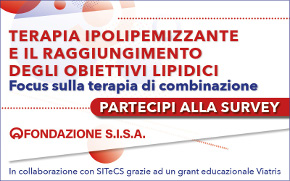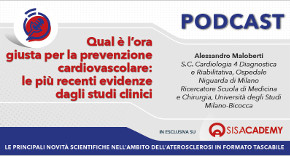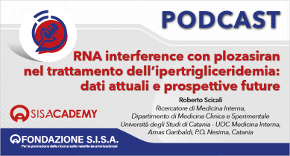 Rivista in lingua italiana
Rivista in lingua italiana
riservata ai Soci SISA
Ultimo numero:
Anno 16 • N.1/2025
Abstract
Pitavastatin: clinical effects from the LIVES Study
Teramoto T.
Atheroscler Suppl 2011;12:285-8
Although clinical trials provide useful information on drug safety and efficacy, results do not always reflect those observed in the real world. The Japanese long-term prospective post-marketing surveillance LIVALO Effectiveness and Safety (LIVES) Study was designed to assess the efficacy and safety of pitavastatin in clinical practice in ~20,000 patients. After 104 weeks, pitavastatin was associated with significant reductions in low-density lipoprotein-cholesterol (LDL-C) (29.1%) that largely occurred within 4 weeks of treatment initiation. In patients with abnormal triglyceride (TG) and high-density lipoprotein-cholesterol (HDL-C) levels at baseline, pitavastatin reduced TG and increased HDL-C by 22.7% and 19.9%, respectively. Overall, 88.2% of the primary prevention low-risk patients attained their Japan Atherosclerosis Society LDL-C target, compared with 82.7% of intermediate-risk patients, 66.5% of high-risk patients and 50.3% of secondary prevention patients. Only 10.4% of pitavastatin-treated patients experienced adverse events (AEs), of which approximately 84% were mild and around 1% was severe. Increases in blood creatine phosphokinase (2.7%), alanine aminotransferase (1.8%), myalgia (1.1%), aspartate aminotransferase (1.5%) and gamma-glutamyltransferase (1.0%) were the most common AEs and only 7.4% of patients discontinued pitavastatin due to AEs. Regression analysis demonstrated that age was not a significant factor for the incidence of any AE or myopathy-associated events. A subanalysis of initial LIVES data focussing on the effects of pitavastatin on HDL-C levels showed that HDL-C was elevated by 5.9% in all patients and by 24.6% in those with low (<l mmol/L; 40 mg/dL) HDL-C levels at baseline (P < 0.0001). A time-course analysis showed that the elevation in HDL-C in the low-HDL-C group was enhanced by 14.0% and 24.9% at 12 weeks and 104 weeks, respectively. In contrast, previous studies have shown that other statins have inconsistent effects on HDL-C levels, with elevations ranging from 0% to 12%. According to a LIVES subanalysis, pitavastatin produced a significant increase in HDL-C levels in patients switching from other statins, suggesting that patients with an unacceptably low level of HDL-C might benefit from switching to pitavastatin. Further analyses showed an improvement in HbA1c in patients with type 2 diabetes after long-term pitavastatin treatment and a significant increase in eGRF in patients with chronic kidney disease. Results from the 5-year LIVES extension study (N = 6,582) showed that long-term treatment with pitavastatin was well tolerated and that the reduction in LDL-C achieved after 104 weeks was maintained for the duration of treatment, whereas levels of HDL-C continued to rise. Importantly, multivariate analysis of the 5-year data showed that, in addition to advanced age (= 65 years), male gender, hypertension, diabetes, and a history of ischemic heart disease, on-treatment levels of HDL-C and LDL-C were significant predictors for cardiovascular (CV) and cerebrovascular risk. In this study, the greatest reduction in CV and cerebrovascular risk was achieved by patients achieving both their LDL-C and HDL-C targets. Overall, results from the LIVES study show that pitavastatin is well tolerated and effectively modifies atherogenic lipid profiles, thereby reducing CV and cerebrovascular risk in Japanese patients with hypercholesterolemia. Pitavastatin's ability to significantly and continually increase HDL-C levels over time suggests a particular benefit for patients with low baseline levels of HDL-C and/or those that fail to increase their HDL-C levels using alternative statins.
Atheroscler Suppl 2011;12:285-8

Area Soci
Eventi
39° Congresso Nazionale
 39° Congresso Nazionale
39° Congresso NazionaleRoma, 23-25 novembre 2025
Save the date




 Spring Meeting Gruppi Giovani SID, SIGG, SIIA, SIMI, SIPREC, SISA
Spring Meeting Gruppi Giovani SID, SIGG, SIIA, SIMI, SIPREC, SISARimini, 6-8 aprile 2025
[continua a leggere]
 SISA LIPID ACADEMY - Corso avanzato di lipidologia clinica
SISA LIPID ACADEMY - Corso avanzato di lipidologia clinicaModena, 4-5 Luglio 2024
[continua a leggere]Giornale Italiano Arteriosclerosi
HoFH today
 Rivista Italiana della
Rivista Italiana della
Ipercolesterolemia
Familiare Omozigote
Anno 6 • N.1/2024
Rivista NMCD
Diateca
[continua a leggere]
[continua a leggere]
Newsletter
il vostro indirizzo di posta elettronica
Progetto LIPIGEN

Nuovo sito dedicato al Progetto LIPIGEN
Progetto LIPIGEN - Vecchio portale
E' necessario essere loggati come utente
Lipigen per poter accedere alla pagina
PROject Statin Intolerance SISA
PROSISA – PROject Statin Intolerance SISA
E' necessario essere loggati come utente
PROSISA per poter accedere alla pagina
GILA - Lipoprotein Aferesi
Gruppo Interdisciplinare Lipoprotein Aferesi
(Accesso Gruppo GILA-Lipoprotein Aferesi)
E' necessario essere loggati come utente del Gruppo GILA per poter accedere
Gruppo Interdisciplinare Lipoprotein Aferesi
(Documentazione ad accesso libero)
Pagina informativa per medici e pazienti










